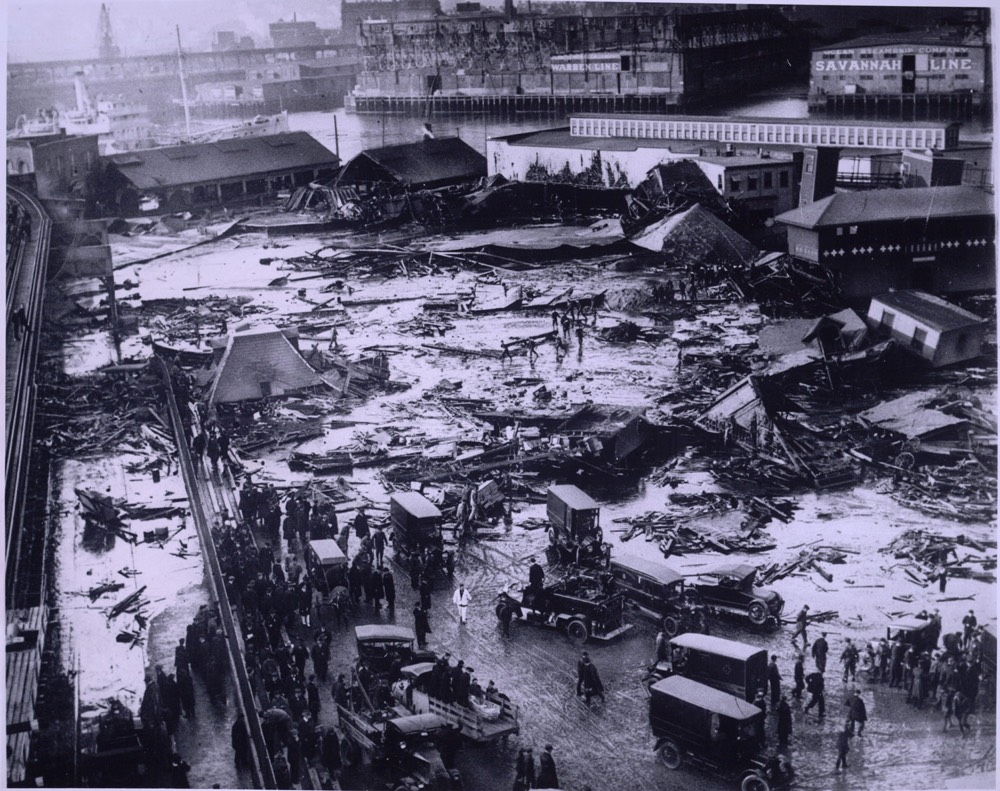Great Molasses Flood of 1919: Why This Deluge of Goo Was So Deadly

A bubbling flood of molasses that sent a towering wave of goo down the streets of Boston in 1919, catching everything from horses to humans in its sticky grasp, killing 21 people, injuring 150 more and flattening buildings in its wake. Now, scientists have figured out why the deluge of viscous sweetener was so deadly.
Cool temperatures may have caused the spilled molasses to flow more slowly, complicating attempts to rescue victims and to begin recovery and cleanup, researchers report in a new study.
On Jan. 15, 1919, shortly after 12:40 p.m. local time, a giant storage tank 50 feet (15 meters) tall and 90 feet (27 m) wide on Boston's waterfront at the Purity Distilling Co. collapsed in the city's crowded North End, according to newspapers at the time. It released more than 2.3 million gallons (8.7 million liters) of molasses. [The 10 Weirdest Spills in Nature]
The wave from the flood, which reached about 25 feet (7.6 m) tall, oozed at more than 50 feet per second (15 m/sec), the researchers of the new study said. It took just moments for the molasses — a standard sweetener at the time — to engulf Boston's Commercial Street area.
According to a report from The Boston Post from 1919, "Molasses, waist deep, covered the street and swirled and bubbled about the wreckage ... Here and there struggled a form — whether it was animal or human being was impossible to tell. Only an upheaval, a thrashing about in the sticky mass, showed where any life was ... Horses died like so many flies on sticky fly-paper. The more they struggled, the deeper in the mess they were ensnared. Human beings — men and women — suffered likewise."
How molasses flows
Scientists began investigating the science of this disaster this year, after undergraduate students produced a video about the flood in May. "To gather relevant details about the flood and its aftermath, I've read hundreds of pages of historical accounts and contemporary newspaper articles, studied century-old maps of buildings in the area, and even called the National Weather Service to request historic meteorological data," lead study author Nicole Sharp, a Denver-based aerospace engineer and fluid dynamicist, said in a statement.
The scientists also investigated the properties of blackstrap molasses, focusing on how temperature affected its rate of flow. "The goal is to take our knowledge and understanding of highly viscous spreading flows and apply that to the Boston Molasses Flood," Sharp said in the statement. [The Mysterious Physics of 7 Everyday Things]
Get the world’s most fascinating discoveries delivered straight to your inbox.
The researchers found that at the time of the collapse, the air temperature would have been around 41 degrees Fahrenheit (5 degrees Celsius). The molasses, however, had arrived from the Caribbean to top off the tank only two days before the flood, and was likely a balmy 50 to 68 degrees F (10 to 20 degrees C) when it was first delivered. Boston winter temperatures would have cooled the molasses down, but it would still likely have been a few degrees warmer than the surrounding air, Sharp said.
Once the tank collapsed, the molasses started flowing quickly over the waterfront. The scientists found that temperature could greatly influence molasses's viscosity, or the degree to which it resists flowing.
"Temperatures dipped just below freezing the night following the accident," Sharp told Live Science. "Based on our data, it's possible the viscosity of the molasses increased by a factor of four or more due to that drop in temperature. That does not sound like such a big difference, but the high viscosity of the molasses was a major factor for rescue work."
For example, "a group of men were trapped in a nearby firehouse when the molasses knocked the building off its foundation and caused the upper floor to collapse atop them," Sharp said. "Reaching them took hours, and one of the men, George Layhe, grew so exhausted fighting against the molasses hour after hour that he ultimately drowned when he could no longer hold his head up."
Tank failure
The tank had its share of issues even before the disaster.
"The molasses tank was originally built in December 1915 under the direction of a manager, Arthur Jell, with no technical background," Sharp said. "The tank leaked throughout its short lifetime, and the response of United States Industrial Alcohol's management to the comments and complaints about the leakage was to paint the tank brown so that the leaks were less noticeable." (United States Industrial Alcohol was the parent company ofthe Purity Distilling Co.)
"As an engineer, one of the things that struck me about the whole affair was the lack of professional ethics involved," Sharp said. "We engineers have a professional and a moral obligation to ensure that what we design and build is safe. People's lives and livelihoods are at risk if we fail. The Boston Molasses Flood is a reminder of what can happen when corners are cut and when warnings about a structure's failing integrity are ignored."
Sharp hopes to figure out what was going on in the tank prior to its collapse. "Two days before the rupture, warm molasses was pumped into the bottom of a tank of cold molasses," she said. "Historical accounts say that the tank walls 'groaned' after such deliveries, presumably due to the mixing between the warm and cold molasses. That's a problem I'd like to simulate using computational fluid dynamics, both to try and address the rumbling described by accounts and to have a clearer idea of what temperature the molasses might have been at the time of the disaster."
The physics of the Boston Molasses Flood are relevant to other accidents that affect the public, including industrial spills or breaking levees. However, the main goal of this work is education.
"Ultimately, I hope that by shedding some light on the physics of a fascinating and surreal historical event, our work can inspire a greater appreciation for fluid dynamics among our students and the public," Sharp said.
Sharp and her colleagues Jordan Kennedy and Shmuel Rubinstein, both at Harvard University, detailed their findings today (Nov. 21) at the annual meeting of the American Physical Society's Division of Fluid Dynamics in Portland, Oregon.
Editor's Note: This article was updated to correct the temperature of the molasses when the disaster happened.
Original article on Live Science.



